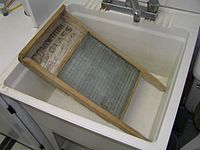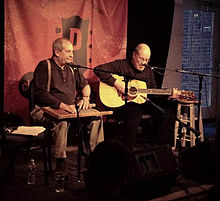Washboard
Washboard may refer to:
-
Washboard (laundry)
This article is about the tool used to hand wash laundry. For the musical percussion instrument, see Washboard (musical instrument). For other uses, see Washboard (disambiguation).
a glass washboard
A washboard is a tool designed for hand washing clothing. With mechanized cleaning of clothing becoming more common by the end of the 20th century, the washboard has become better known for its secondary use as a musical instrument.The traditional washboard is usually constructed with a rectangular wooden frame in which are mounted a series of ridges or corrugations for the clothing to be rubbed upon. For 19th-century washboards, the ridges were often of wood; by the 20th century, ridges of metal were more common. A "fluted" metal washboard was patented in the United States by Stephen Rust in 1833.[1] Zinc washboards were manufactured in the United States from the middle of the 19th century. In the late 20th century and early 21st century, ridges of galvanized steel are most common, but some modern boards are made of glass. Washboards with brass ridges are still made.Many parts of the world still use washboards for washing clothes.[2] Clothes are soaked in hot soapy water in a washtub or sink, then squeezed and rubbed against the ridged surface of the washboard to force the cleansing fluid through the cloth to carry away dirt. Washboards may also be used for washing in a river, with or without soap. Then the clothes are rinsed. The rubbing has a similar effect to beating the clothes and household linen on rocks, an ancient method, but is less abrasive. Military personnel often use washboards to do their laundry when no local laundry facilities exist.[3]Some experts emphasize that using a washboard is superior to using modern laundry machines because it saves water and electricity and is not so hard on the clothing 
Woman on an Israeli Kibbutz using a washboard to do laundry 
Glass Washboard - Music
- Washboard Rhythm Kings, a loose aggregation of jazz performers from the 1930s
- Washboard Jungle, a four-man American musical group formed in 1989
- Washboard Sam (1910-1966), U.S. blues musician
- Washboard Willie (1909-1991), U.S. blues musician
- Washboard Blues, a popular song written by Hoagy Carmichael
- Geography
- Washboard Falls, a waterfall in Ontario Canada
- Washboard Junction, Utah, a highway junction in the U.S. state of Utah
- Other
- washboard abs, referring to rippled appearance of the rectus abdominis muscle
- washboard stomach, same as washboard abs
- Washboarding, transverse ripples in the surface of gravel and dirt roads
- Washboard moraine, a landform caused by glaciers





No comments:
Post a Comment